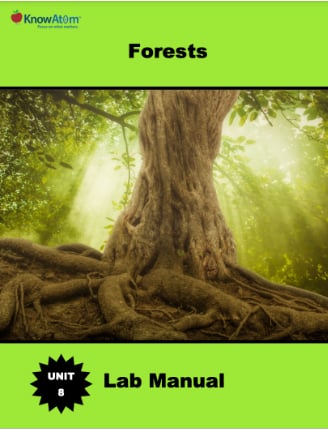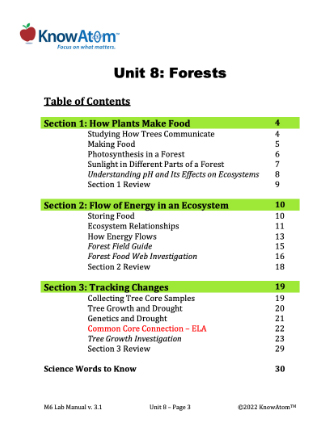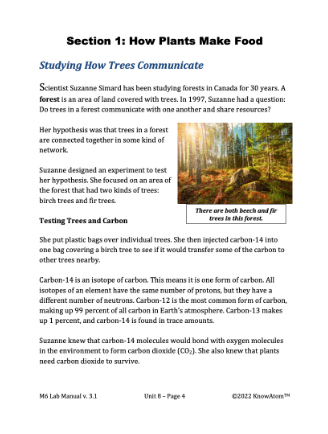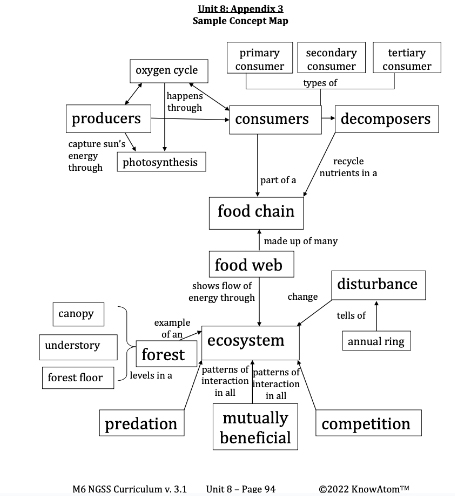Once students understand how plants capture the sun’s energy and turn it into usable energy, students analyze the phenomena of how energy moves through a forest food web as organisms eat one another.
In this unit, students explore forest ecosystems, studying the science phenomena of interactions between living things and the environment. In this lesson, students build on their understanding of how energy affects the growth of organisms by exploring the phenomena of forest food webs, and analyzing how the phenomena of drought can have a ripple effect through the ecosystem. This page showcases all components of this lesson.
The science background section gives teachers more in-depth information on the phenomena students encounter. Below is an excerpt of the science background information from this lesson on forest food webs.
An ecosystem is a community of different species that depend on interacting with each other and their physical environment for survival. All ecosystems include living things that must eat one another for energy and nutrients, as well as nonliving things such as oxygen and carbon dioxide from the atmosphere, water, and energy from the sun. An ecosystem can be as large as a forest or as small as an oak tree. Regardless of its size, all the parts of an ecosystem work together to make a balanced system.
There are competitive and mutually beneficial interactions in every ecosystem. There are also predatory interactions in every ecosystem. Predation is an interaction that occurs when one organism (a predator) eats another organism (prey). Hawks and foxes are both predators of gray squirrels.
All of the energy a tree gathers from sunlight is spread throughout the forest ecosystem. When organisms eat one another, energy gets passed along in the form of chemical bonds holding together the molecules of glucose. When plants make glucose during photosynthesis, or animals eat plants or other animals and absorb glucose, that glucose moves to the mitochondria of their cells.
It is the job of the mitochondria to perform a chemical reaction called cellular respiration. In cellular respiration, oxygen converts some of the energy in the glucose into energy that is stored in molecules called adenosine triphosphate, or ATP. The energy found in glucose cannot be used by cells until it is stored in molecules of ATP. Because of this, cellular respiration is always happening in cells.
As energy flows from the sun to producers and then to consumers and decomposers, it is always moving in one direction through the food web. As organisms eat one another, some energy is lost to heat as cells perform cellular respiration. As a result, life requires a constant supply of energy from the sun.
In contrast, matter is always cycling through ecosystems. Most of the matter that is on Earth today has been around since the planet first formed. Matter is transferred and recycled at every level of a food web.
Photosynthesis and cellular respiration cycle oxygen and carbon dioxide between the atmosphere and living things. In the atmosphere, carbon bonds with oxygen to form carbon dioxide. When plants take in carbon dioxide to perform photosynthesis, some of the carbon atoms are used for growth, becoming part of the plant. When animals eat plants, they absorb those carbon atoms. When plants and animals die, decomposers break down the carbon atoms and return them to the environment. This is called the carbon cycle, and it is closely linked to the oxygen cycle.
Once students understand how plants capture the sun’s energy and turn it into usable energy, students analyze the phenomena of how energy moves through a forest food web as organisms eat one another.

Prepared hands-on materials, full year grade-specific curriculum, and personalized live professional development designed to support mastery of current state science standards.
Competition : an interaction between organisms that occurs whenever two or more organisms require the same limited resource
Consumer : an organism that eats other organisms; there are three possible levels of consumer in a food chain: primary, secondary, and tertiary
Decomposer : an organism that breaks down organic waste and feeds on the nutrients
Disturbance : an event that changes conditions in an ecosystem
Ecosystem : a community of different species that depend on interacting with each other and their physical environment for survival
Food Chain : the path that energy travels as one organism eats another
Food Web : a visual that shows the network of food chains in an ecosystem
Predation : an interaction between two organisms that occurs when one organism (a predator) eats another organism (prey)
Primary Consumer : the second level of a food web but the first level of organisms that get energy by eating producers
Producer : an organism that captures energy directly from the sun to make its own food; trees, grasses, and some microbes do this with photosynthesis; the first level of organisms in all food webs are producers
Secondary Consumer : the third level of a food web; an organism that eats primary consumers
Tertiary Consumer : the fourth level of a food web; an organism that eats secondary consumers
Storing Food
Eastern gray squirrels love acorns. Acorns are the seeds of oak trees. Right before a squirrel eats an acorn, it shakes it.
The shaking happens so quickly it can be hard to see. But Michael Steele has videoed squirrels eating. When he watched the videos in slow-motion, he saw squirrels shaking the acorns.
Michael is a researcher who has studied squirrel behaviors. He says there is a simple explanation for why the squirrels shake acorns. They want to know if the quality of the seed is good. Depending on what they sense, they will either eat the seed right away or bury it to eat later.
Why Squirrels Bury Seeds
Squirrels bury seeds so they will have enough food to last them through the winter. Squirrels need to eat acorns and other plant materials because they are animals. They cannot make their own food, as plants can. Instead, they have to eat other organisms for energy and nutrients. When squirrels eat acorns, they access some of the energy that the oak tree has produced through photosynthesis and stored in glucose molecules.
Ecosystem Relationships
Michael is particularly interested in relationships between squirrels and the trees that produce squirrels’ food. Both the squirrels and the trees are part of an ecosystem. An ecosystem is a community of different species that depend on interacting with each other and their physical environment for survival. All ecosystems include living things that must eat one another for energy and nutrients. They also include oxygen and carbon dioxide from the atmosphere, water, and energy from the sun.
An ecosystem can be as large as a forest or as small as an oak tree. Regardless of its size, all the parts of an ecosystem work together to make a balanced system.
Mutually Beneficial Relationships
Michael has found that squirrels and oak trees have a mutually beneficial relationship. The squirrels benefit because they need the seeds’ energy and nutrients. They also need oxygen to breathe in. The oak trees benefit because acorns don’t grow well if they are right beneath the parent tree. The branches of the parent tree will block the sun.
The squirrels move acorns to bury them. Gray squirrels are known as scatter hoarders. This is because they bury acorns and other seeds in many places. Researchers have found that gray squirrels have a system when they bury acorns from an oak tree. They bury less-desirable acorns closest to the tree. They bury more-desirable acorns farther away from the tree.
If the squirrel doesn’t make it back to its acorns, those acorns might grow into new trees. This benefits the oak tree because it has passed along its genes. It also benefits the squirrels because it means more food sources.
Squirrels have a competitive relationship with one another. Competition between organisms occurs whenever two or more organisms require the same limited resource. Water and food are both resources. Shelter is another resource. Squirrels will often take another squirrel’s supply of buried seeds if they find them. Because of this, gray squirrels will bury thousands of seeds each season.
There are competitive interactions in every ecosystem. There are also mutually beneficial interactions in every ecosystem.
There are also predatory interactions in every ecosystem. Predation is an interaction that occurs when one organism (a predator) eats another organism (prey). Organisms can be both predators and prey. For example, squirrels are prey to hawks and foxes. Squirrels are also predators of acorns and other plants.
In a balanced ecosystem, predators and prey act as checks on one another so that no one population of organisms becomes too large. A population is all of the members of a species within a particular area.
Food Chains and Food Webs
Oak trees, squirrels, and hawks are all connected together in a food web. A food web is a visual that shows the network of food chains in an ecosystem. Food chains show specific paths that energy travels as one organism eats another. Each level of a food web or food chain is called a trophic level.
Scientists study how energy flows through ecosystems to better understand how different organisms are connected together. They group organisms within an ecosystem according to how they obtain energy in a food web.



In this lesson students develop models to analyze the impact of drought phenomena on temperate deciduous forest food webs in Massachusetts. Students use their food web models to figure out how the flow of energy in the phenomena of a forest food web changes during a period of severe drought, causing a ripple effect in the populations of other organisms as a result.
KnowAtom incorporates formative and summative assessments designed to make students thinking visible for deeper student-centered learning.

Standards citation: NGSS Lead States. 2013. Next Generation Science Standards: For States, By States. Washington, DC: The National Academies Press. Neither WestEd nor the lead states and partners that developed the Next Generation Science Standards were involved in the production of this product, and do not endorse it.